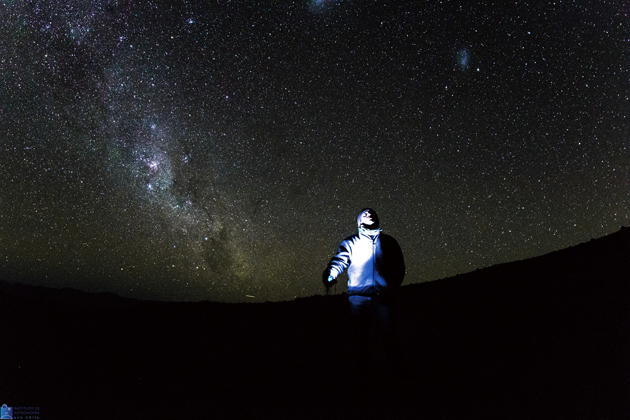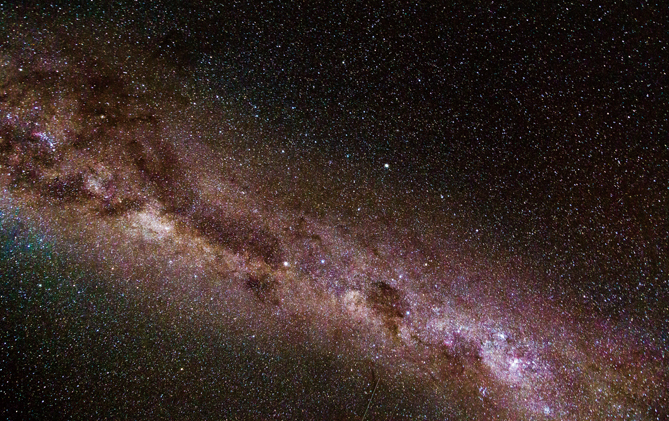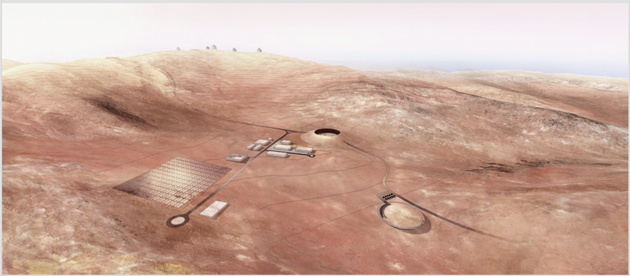WANG Wei & WANG Zhong
China-Chile Joint Center for Astronomy, National Astronomical Observatories,
Chinese Academy of Sciences, Beijing 100101, China
The Chinese Academy of Sciences South America Center for Astronomy (CASSACA), also known as China-Chile Joint Center for Astronomy (CCJCA), is one of the overseas research centers initiated by the Chinese Academy of Sciences (CAS) to develop cooperation in science and technology with other countries. Its sponsoring institution in China is the National Astronomical Observatories (NAOC) of CAS in Beijing, and it is hosted in Chile by the University of Chile’s Faculty of Physical and Mathematical Sciences. CASSACA serves as a liaison for closer collaboration in astronomical research and related technology development with Chile and other South American countries, as well as with all other international observatories stationed in Chile. It was inaugurated in Santiago in October 2013, and has been expanding its operations ever since. It now has a team of about 20, including science and administrative staff, long-term visiting scholars, postdocs and graduate students. CASSACA has built effective collaborations with a number of Chilean institutions, supported many young scientists, and developed mutually-beneficial research programs. In addition, it has worked on preparing for future development projects in Chile that are being contemplated by the scientific community in China.

An astronomer is seen making observation from the top of the Andes in Chile. Glitering on the back is the Milky Way.
Known world-wide as the “Nation for the Stars”, Chile occupies a very special position in observational astronomy, by virtue of its unique geographic and atmospheric conditions, and further bolstered by its government’s open and full-hearted support for research activities. Many developed countries have, over more than half a century, built increasingly large and sophisticated observing facilities in Chile and reaped remarkable rewards in scientific discoveries. Among the more than half a dozen major international observatories, there is a world-class research community and the most advanced support infrastructure for astronomical instruments. Taking advantage of the benefits as the host nation, Chilean astronomers and visiting scholars in Chilean institutions enjoy unparalleled access to these observing facilities. This provides a wide range of opportunities for collaborations.

“Nation for the Stars:” By virtue of its unique geographic and atmospheric conditions, the Republic of Chile enjoys a very special position in observational astronomy. Shown here is a view of the Milky Way from the mountain-top of the Andes within its terrestories.
Geographically, China and Chile are on the two opposite sides of the world, so one of the urgent tasks that CASSACA faced in its first few years was to bring scientists of the two nations together and make it easier for them to learn about each other’s work. With the support of research universities and observatories, CASSACA was able to help arrange many Chinese scientists to visit Chile, and vice versa. Several increasingly large-scale conferences were organized and numerous smaller workshops were held on specific research topics, both in China and in Chile. Through short- and long-term visiting programs promoted and sponsored by CASSACA, communal scientific interests were cultivated, students were exchanged, instruments were shared, and observing proposals and research papers were co-authored. Many Chinese astronomers had the chance to use the most advanced observing facilities in Chile that would not have been available to them otherwise, while Chilean astronomers obtained support and help from Chinese colleagues they didn’t know before. Several graduate students even found co-advisors for their thesis from the other country.
Since its early operations, CASSACA has managed a Postdoctoral Fellowship program together with National Commission for Scientific and Technological Research in Chile. This Fellowship is aimed at providing young scientists, regardless of their countries of origin, with opportunities that draw upon the astronomical research strengths and facilities of both Chile and China. In the last four years, it has received more than 100 applications from all over the world and gained increasing recognition internationally as a significant fellowship in astronomy. A number of CASSACA’s fellows have made breakthroughs in their fields of research and published high visibility results. The majority of earlier Fellowship recipients in the first two rounds had already finished their fellowship tenures and moved on to secure long-term professional (i.e. faculty) positions, a testament to both the dedicated work of these young scientists and the strength and quality of the Fellowship selection.

The inauguration of the CASSACA office in Santiago.

A conceptual design for the future NAOC Chile headquarters near Santiago.
In collaboration with experts of Santa María University and others in the Chilean/Chinese research communities, CASSACA launched an astronomy data center in 2016 to archive a large amount of observational data in the public domain, and to provide online search service to scientists working in Chile. Due to the limitation of the existing network connectivity, astronomers in South America have difficulties in accessing and operating on large volumes of existing archival data in a timely fashion. This data center, now in test operation, employs the latest information technology, with much of the hardware provided by high-tech manufacturers based in China, to host a special portal that focuses on the observational data made available locally. It is designed to significantly enhance the “data mining” experience of scientists working in Chile and increase their research productivity. It is also expected to help Chinese astronomers to gain experience and access to a vast, previously untapped data repository and will start providing public services to researchers early next year. Given the rapid growth of the observational data volume, especially those from astronomical facilities located in Chile, CASSACA is in consideration to enlarge its data hosting capacities in the near future.
To further develop bilateral cooperation and foster promising science teams, CASSACA has supported collaborative projects with special research grants awarded on a yearly basis since 2015. Proposed candidate programs are evaluated by a panel of scientists from both Chile and China, based on both scientific merits and the importance to the growth prospects of the two communities. Two previous rounds of AOs (announcement of opportunities) in 2015 and 2016 were highly successful, through a fiercely competitive process, in producing fruitful scientific results in research fields of theory, observation and astronomical instrumentation. For the 2018 fiscal year, a new call has been issued recently and in addition to the previously existing fields, “observational site survey” has been included as one of the new categories in which future projects will be supported.
One of the CASSACA’s main missions is to study the feasibility of developing China’s own observational facilities in Chile. The northern part of Chile around the Atacama Desert is commonly regarded as the best place for ground-based astronomical observations in the optical, infrared, and radio (submillimeter to millimeter) windows, given its high fraction of clear nights (>80%), stable atmospheric conditions, dry air and dark sky background. Now under active constructions are the “next generation” telescopes including the LSST (Large Synoptic Survey Telescope), E-ELT (Extremely Large Telescope), GMT (Giant Magellan Telescope) and CTA (Cherenkov Telescope Array), each an investment costing over one billion US dollars. Chinese astronomers have clearly realized the need to join this international enterprise and make use of the best environment as well as the unique infrastructure available to their future research.
With the support of University of Chile, NAOC (CASSACA’s sponsoring institution) was granted the International Research Organization status in Chile by the Chilean government, through a presidential decree issued in April 2016. This is a privilege that allows NAOC to develop its future facilities and observatories in Chile. A lengthy investigation conducted by CASSACA has led to several possibilities, especially regarding the Cerro Ventarrones (hereafter VTRS) Observatory project. In November 2016, representatives of NAOC and Catholic University of the North (UCN) signed a Memorandum of Understanding (MOU) to jointly develop VTRS, a 25 square-kilometer site near the city of Antofagasta, into a world-class astronomical observatory. In late 2017, CASSACA and UCN have installed several container-style offices at the mountain top 2,900m above the sea level, equipped with a diesel generator, and a full set of site-testing instruments to measure atmospheric stability and a weather station to monitor the climate changes.

Chinese and Chilean scientists discussing a telescope project organized by CASSACA.
After some intensive studies and on-site surveying campaigns by many experts from both countries, a preliminary master plan for the future VTRS observatory was proposed recently, which will serve as guidance and a roadmap for development. As the leading force and chief coordinator of this major effort, CASSACA is devoting significant resources in helping NAOC to manage the planning and design of access road constructions, power and water supplies, working and living facilities, support infrastructures and communication solutions. It is envisioned that large-scale building activities will take place in the next few years, and with it, VTRS will become the first major Chinese astronomical observatory overseas, and the first scientific facility of such scale built by China on the South America continent.
In the meantime, and in anticipation of the growing needs to develop future observational facilities in Chile, NAOC is also contemplating its science and administrative headquarters in this country, similar to what has been done by several other countries such as the US, European Union and Japan. With the assistance of CASSACA, it has managed to secure a piece of land near Santiago that is nearly perfect for this purpose. Several preliminary conceptual designs for this place were proposed, and they are now being compared and discussed at various levels within CAS. There are even suggestions to enlarge this planned headquarters of NAOC into a campus or science park, which would be able to accommodate other offices and laboratories representing the diverse interests among the more than 100 research institutions under the CAS umbrella.
Thanks to the support of CAS/NAOC and the help from its Chilean host, CASSACA has grown significantly in scale and scope over the last five years. It is now widely considered a success story in promoting science and building mutually-beneficial relationships. As an experimental step taken by CAS to extend its scientific research overseas, CASSACA continues to explore and learn how to best carry out its core missions while keep attracting and retaining high quality research talent, and producing the best science. Among all natural sciences, astronomy is the ideal testing ground for international cooperation. CASSACA is proud and fortunate to be one of the newest channels that bring the research communities of China and the rest of the world closer together.

A conceptual design for the VTRS observatory near Antofagasta, Chile.

